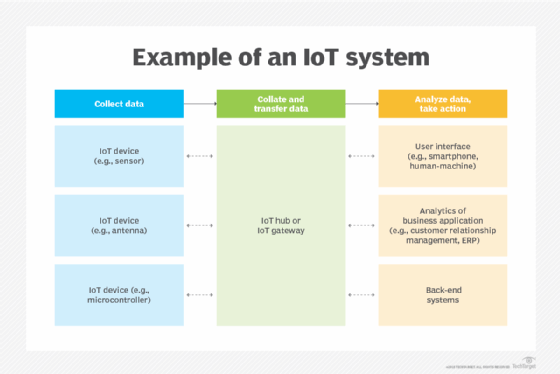
Kit Wai Chan - Fotolia
Get to know Microsoft's Azure IoT services
With so many connected devices distributed across the globe, enterprises need a way to manage and monitor their IoT assets. See what Azure services are available to help.
From counting our steps to heating our homes, the internet of things is a part of everyday life. All of these smart devices collect data, but enterprises need to gather, process and draw insights from the data these smart devices collect.
Microsoft offers a portfolio of Azure IoT services to build, connect, secure and manage devices and assets. Enterprises can choose to develop custom projects or use templates to speed the development process. Explore these Azure IoT services to see if any of them fit your needs.
Azure IoT Hub
Azure IoT Hub monitors and manages IoT assets in the cloud. The monitoring feature tracks different events -- such as device failure and connections -- to sustain overall system health. Users can manage numerous tasks, including file uploads to the cloud, message routing and secure device access. Azure IoT device SDKs are available to build apps, and they support languages such as Java, Node.js and Python. IoT Hub integrates with Azure Event Grid, Azure Logic Apps, Azure Machine Learning and Azure Stream Analytics.
Azure IoT Edge
Azure IoT Edge is similar to IoT Hub, except it analyzes data directly on devices rather than in the cloud. This reduces messaging to the cloud and cuts down on the time it takes to gather insights locally. The IoT Edge runtime installs and updates workloads on devices, reports module health, maintains security and facilitates communication among devices, modules and the cloud.
Azure IoT Central
Azure IoT Central is a SaaS offering that manages and monitors IoT assets. It lacks some of the granular control found in other Azure IoT services, but it also requires less setup, management and operational overhead. Devices exchange information such as measurements and synchronizations with the IoT Central applications. The service stores app data in the cloud, such as device templates and user information.

Azure IoT solution accelerators
These accelerators are ready-to-deploy templates designed to address common IoT scenarios, such as predictive maintenance and remote monitoring. The source code is available in GitHub and can be customized to meet specific requirements. A web app is included in each accelerator's code for management needs. The templates are scalable, extensible, modular and secure.
Azure Sphere
Azure Sphere is an application platform specifically designed for building secure internet-connected devices. It's made up of a microcontroller unit (MCU) to support real-time processing and run high-level OSes. With this platform, enterprises can remotely update, monitor and maintain connected devices. Azure Sphere Security Service ensures that the MCUs are securely connected.
Azure Digital Twins
Azure Digital Twins provides spatial intelligence capabilities to track relationships among physical devices, sensors and people. When devices send telemetry data, developers follow a four-step process: validate, match, compute and dispatch. Enterprises can extract deeper insight from Azure Digital Twins apps by connecting to analytics, AI and storage services. For endpoint routing, the service supports Event Hubs, Service Bus and Event Grid.
Azure Time Series Insights
Azure Time Series Insights (TSI) is a PaaS offering that processes, stores, visualizes and queries time series data generated by IoT devices. Time series data shows how something changes over a certain time frame, and this service can use past information to predict future changes. Azure TSI integrates with IoT Hub and Event Hubs to access their events. Admins can simultaneously visualize real-time and historical data via the interface to discover trends and abnormalities.
Azure Maps
Azure Maps is a collection of APIs that provide mobile and web applications with mapping data to give geographic context. The service uses geospatial data and a set of REST APIs to incorporate various styles of satellite imagery into applications. It is made up of six services: Render, Route, Search, Time Zone, Traffic and IP to Location. A common use would be a mobile mapping application that shows traffic or nearby areas of interest.
Azure Stream Analytics
Azure Stream Analytics is a managed event processing engine that analyzes streaming data from devices, sensors and more. Since it is a serverless offering, it sets up and manages complex compute clusters for users and executes performance tuning. Stream Analytics relies on Azure Event Hubs and Azure IoT Hub to ingest millions of events per second and can obtain historical data from storage services, such as Azure Blob, SQL Database and Cosmos DB.








